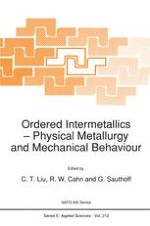1992 | OriginalPaper | Chapter
Creep in L12-Intermetallics
Authors : J. H. Schneibel, P. M. Hazzledine
Published in: Ordered Intermetallics — Physical Metallurgy and Mechanical Behaviour
Publisher: Springer Netherlands
Included in: Professional Book Archive
Activate our intelligent search to find suitable subject content or patents.
Select sections of text to find matching patents with Artificial Intelligence. powered by
Select sections of text to find additional relevant content using AI-assisted search. powered by
Several intermetallic compounds with the L12-structure exhibit a yield strength anomaly (YSA), i.e., the yield stress increases as the temperature increases. As shown for Ni3Al, no corresponding “creep strength anomaly” exists. The creep strength decreases in a normal manner with increasing temperature. Its orientation dependence is different from that observed in the YSA regime. The transient creep of Ni3Al is composed of a normal (“work hardening”) and an inverse (“work softening”) part. The reasons for such transients are discussed. Specific models for the dependence of strain rate vs. strain during inverse creep as well as for the orientation dependence of the creep strength are reviewed and compared with experiments. Experiments and models indicate that the strain rate ε depends on the strain ε approximately as ε or ε2/3. The orientation dependence of the creep strength is particularly pronounced at low temperatures and changes at high temperatures and low stresses. At low creep stresses, Ni3Al is not as strong as high-strength superalloys, due to its low stress exponent. However, further optimization may be possible. As to the creep of other L12-compounds, very little information is available and no distinct evidence for inverse creep has been found. This may be due to the lower yield stresses and less pronounced YSA in these compounds.
